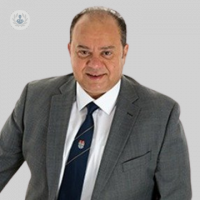Caudal epidural pulsed radiofrequency treatment: A new horizon in pain management
Written in association with:Caudal epidural pulsed radiofrequency (PRF) treatment is an innovative approach to managing chronic pain, particularly in the lower back and legs. This minimally invasive technique utilises electrical pulses to modulate nerve activity, providing significant pain relief without the need for more aggressive interventions such as surgery. Here to explain more is esteemed pain management specialist, Dr Yasser Mehrez.

What is caudal epidural PRF treatment?
Caudal epidural PRF treatment involves the delivery of pulsed radiofrequency energy through a needle inserted into the caudal epidural space at the base of the spine. Unlike continuous radiofrequency ablation, which uses heat to destroy nerve tissues, PRF employs short bursts of high-frequency electrical current to alter the transmission of pain signals. This method is believed to cause less damage to surrounding tissues while effectively reducing pain.
Who can benefit from this treatment?
This treatment is primarily recommended for patients suffering from chronic lower back pain, sciatica, and certain types of neuropathic pain that have not responded well to conventional therapies. Candidates for caudal epidural PRF typically include those who have tried physical therapy, medications, and other non-invasive treatments without satisfactory results.
How is the procedure performed?
The procedure is usually performed on an outpatient basis. After administering local anesthesia to minimise discomfort, a physician uses fluoroscopic guidance to accurately place the needle in the caudal epidural space. Once in position, pulsed radiofrequency energy is delivered for a few minutes. Patients may experience mild discomfort during the procedure, but it is generally well-tolerated.
What are the expected outcomes?
Patients undergoing caudal epidural PRF treatment often report significant pain relief within weeks, with effects lasting several months to a year. The procedure has been shown to improve mobility and quality of life, allowing patients to engage in daily activities with less pain. However, the degree of pain relief can vary based on individual factors, including the underlying cause of pain and overall health.
What are the risks and side effects?
As with any medical procedure, caudal epidural PRF treatment carries some risks, including infection, bleeding, and nerve damage, though these are rare. The most common side effects are temporary pain at the injection site and mild post-procedural discomfort.


